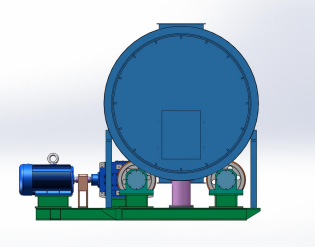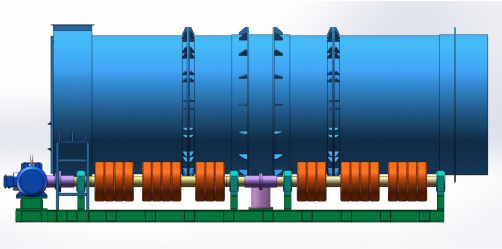Sintering Mixed Granulation Process (2)
HPS mixed granulation process
HPS mixed pellet sintering belongs to the small pellet sintering process, which is to mix iron ore powder, returned ore, flux and fuel with water to make small balls with a diameter of 5-10mm, wrap a certain proportion of solid fuel on the surface of the small balls, and then sinter. Compared with the common sintering method, the small pellet sintering method has increased the process links of strengthening granulation and rolling pulverized coal outward.
Intensified granulation is to add a disc pelletizer between the first and second mixtures to make the mixture into small balls of 5-10mm. Fuel addition is to add 20%-30% of internal pulverized coal in the batching chamber. After pelletizing, 70%-80% of external pulverized coal is added. The outer blending coal wrapped on the surface of the pellet can change the combustion conditions of the fuel during sintering, improve the air permeability of the material layer, improve the production capacity and reduce the fuel consumption. Rolling coal has the following two functions: one is to make the pulverized coal evenly and firmly adhere to the surface of the pellet; The other is to make the surface of the pellet smooth after rolling for a period of time again, further improving the air permeability of the material layer.
MPS mixed granulation process
MPS is to roll 70%-80% of pulverized coal outside the last stage of cylinder granulation in the three-stage cylinder mixed granulation process. First, the materials are preliminarily mixed, then the materials are granulated to form small balls, and the prepared small balls are proportionally mixed with fine pulverized coal before entering the following mixing. The final mixture is a coal roller, and the pulverized coal is wrapped on the surface of the ball and compacted. The finished mixture directly enters the sintering machine. This process has the following characteristics: improving the air permeability of the material layer, increasing the thickness of the material layer, improving the sinter strength, increasing the utilization coefficient and reducing the fuel consumption, etc.
Comparison of Mixed Granulation Processes
(1) When fine ore sintering or concentrate ratio is not high, the mixed granulation process with two-stage cylindrical mixer can meet the production requirements. Moreover, the cylinder mixer is simple in structure and reliable in operation. It is a common configuration in domestic sintering plants.
(2) In order to prolong the granulation time, large sintering plants adopt a three-stage mixed granulation process, initially using a cylindrical mixer to mix the materials evenly, and subsequently using a cylindrical granulator to meet the granulation time requirements. Compared with the mixed granulation of two-stage cylinders, the configuration of one more stage of cylinders can effectively improve the particle size composition of materials and reduce the proportion of materials below 3mm.
(3) With the application of intensive mixer in sintering, some factories use intensive mixer instead of primary mixer, and cylinder granulator is still used in granulation stage. The mixing effect of the intensive mixer is better, but the overhaul frequency of the intensive mixer is relatively high, so in this process configuration, the bypass process of materials should be generally considered. When the intensive mixer is overhauled, the materials do not pass through the intensive mixer but directly enter the following mixer. Or, the returned ore does not enter the intensive mixer, but is added to the discharge belt conveyor of the intensive mixer to avoid excessive wear of the blades of the intensive mixer by the returned ore, thus increasing the maintenance frequency of the intensive mixer.
(4) Under the condition of high concentrate ratio, the conventional two-stage mixed granulation cannot meet the requirements, and enhanced granulation measures are needed to ensure the granulation effect. Therefore, in this case, small ball sintering method can be adopted to improve the granulation effect, such as HPS mixed granulation process or MPS mixed granulation process. The results show that when the granulation time is less than 8min, MPS granulation effect is better than HPS, and its corresponding sintering speed, utilization coefficient and sinter falling strength are also better.
When the granulation moisture content is 7%, all indexes of MPS exceed HPS. Both methods can form ferric acid well, but the sinter sintered by MPS has higher calcium ferrite content, perfect and ideal calcium ferrite crystallization, high strength and good reducibility. MPS can be used instead of HPS in factory production. The granulation effect, sinter quality, sinter image and metallurgical properties of these two process configurations are better than those of conventional sintering methods. In these two process configurations, an intensive mixer can also be used instead of a cylindrical mixer.






